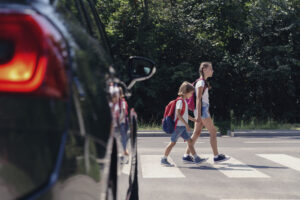Sharing the Road Safely
Pedestrian deaths in the United States are on the rise, prompting serious concern and action. According to Governors Highway Safety Association (GHSA), drivers struck and killed at least 7,508 people walking in 2022 – the highest number since 1981, and an average of 20 deaths every day. The White House recently announced a grant of $44.5 million to the Department of Transportation to improve pedestrian safety on our roads.
struck and killed at least 7,508 people walking in 2022 – the highest number since 1981, and an average of 20 deaths every day. The White House recently announced a grant of $44.5 million to the Department of Transportation to improve pedestrian safety on our roads.
Why Are More Pedestrians Being Hit by Cars?
Distracted Driving: Smartphones and in-car technology cause drivers to take their eyes off the road – texting, talking on the phone, adjusting the radio – potentially leading to a collision.
Speeding: Faster speeds give drivers less reaction time and increase the severity of crashes and pedestrian fatality.
Poor Road Design: Some roads might lack proper crosswalks, sidewalks, or lighting, making it difficult for pedestrians to navigate safely.
The White House grant is a positive step towards improving pedestrian safety. Here are some potential solutions:
Stricter Enforcement of Traffic Laws: Cracking down on distracted driving and speeding can deter dangerous behaviors.
Improved Road Infrastructure: Investing in better sidewalks, crosswalks, and pedestrian-friendly lighting creates safer spaces.
Public Awareness Campaigns: Educating both drivers and pedestrians about safety practices is crucial.
Sharing the Road: Safety Tips for Drivers and Pedestrians
Drivers:
- Minimize Distractions: Put down your phone and avoid activities that take your eyes off the road. This includes texting (illegal), talking on the phone, eating, or adjusting the radio.
- Obey Speed Limits: Slow down, especially in areas with pedestrians like school zones and crosswalks.
- Yield to Pedestrians: Always yield the right-of-way to pedestrians in crosswalks, marked or unmarked. Be aware of pedestrians waiting to cross and those already in the crosswalk.
- Look Out for Pedestrians: Stay alert, especially at intersections, near parked cars, and in areas with limited visibility.
- Use Headlights at Night: Even in well-lit areas, headlights make you more visible to pedestrians.
- Watch Out For: Be extra cautious around children, older adults, and people with disabilities.
Pedestrians:
- Increase Visibility: Wear bright clothing or reflective gear at night or in low-light conditions.
- Use Designated Crosswalks: Always cross the street at designated crosswalks, even if the light isn’t flashing. Look for crosswalks with pedestrian signals for added safety.
- Stay Alert: Put down your phone and avoid wearing headphones that block out traffic sounds. Be aware of your surroundings and pay attention to oncoming vehicles.
- Make Eye Contact with Drivers: Before crossing a street, make eye contact with drivers to ensure they see you.
- Don’t Jaywalk: Cross only at designated areas and wait for traffic to come to a complete stop.
- Be Predictable: Walk in a straight line, don’t dart out, and avoid erratic movements that could confuse drivers.
- Avoid Impairment: Don’t walk under the influence of alcohol or drugs.
By working together and following these safety tips, we can create safer roads for everyone. Remember, sharing the road is a responsibility we all share.


